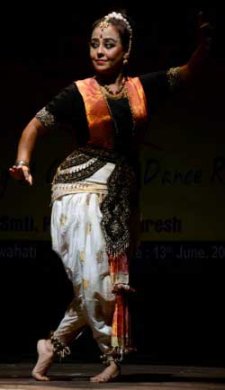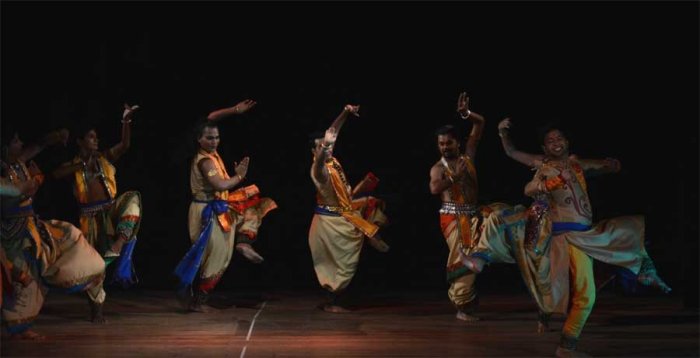
|
 |

|
 |
Prateesha Suresh: Responsibility towards my art - Vijay Shanker e-mail: vijaydance@gmail.com August 13, 2017  The Sattriya dance of Assam has been recognized as one of the eight classical dances of India but many are still unaware of it. Prateesha Suresh is the sole and leading exponent of Sattriya dance in Mumbai. She has also trained in Bharatanatyam at the famous Kalakshetra in Chennai. Prateesha has been consistently promoting Sattriya dance through performances, workshops and seminars in India and abroad. How were you initiated into dance? I took to dance at a very young age even before I could comprehend it as an art form. I feel exhilarated by dance. It is not hereditary as there are no dancers on both sides of my family. Why did you select Sattriya dance to train in? I love all the classical dances. I was initiated into Sattriya at a very young age. Those days the classes were very few and far between. I learnt Bharatanatyam by choice as I wanted the discipline of a classical dance form and at that point of time Bharatanatyam was a natural choice. I took up Sattriya because I felt a responsibility towards my culture as an artist, which is still a motivating factor for me. I wanted to dance at any point of time. Did you experience any difficulty in trying to popularize Sattriya? Yes, I did face a lot of difficulty. 25 years back when I ventured out with this purpose I had to explain to organizers, be it govt. or private, all about the dance form as it was not yet declared classical. It took a lot of effort to explain that it is a "classical" dance. Before dancing, I explained the nuances more in detail which almost became like a lecture demonstration. Apart from this, I left no opportunity to present lecture-demonstrations wherever I could. Explaining the dance form to the media was the most difficult part as it was completely new and no information was available online those days. Does Sattriya have varied dance units - like adavus of Bharatanatyam - and how different is it technically, pertaining to style and presentation? The dance units in Sattriya are called "Mati-akhora" literally meaning 'exercises on the floor'. Apart from dance movements they also include yogic postures which are different from the dance units (adavus) of Bharatanatyam. Yoga postures like kapotasan, mayurasan, pinch mayurasan, dhanurasan, etc. are used with their equivalent names in the dance form to prepare the body for dance. However these are not used in the dances or dance items. The body postures in dance include samabhanga, dvibhanga and tribhanga and the arms move with bent elbows and in a fluid manner as against the straight lines and geometric patterns of Bharatanatyam. As the dances were confined to their presentation only in the Namghar or prayer hall with devotees sitting at all three sides, each movement was repeated on all four sides starting with the front of the "Simhasan" (the main place of worship where the Bhagavad takes the prime place instead of any idol of God) to all the other three sides. The dance is a part of its founder Shrimanta Shankardev's religion "Eka-Sharan-Naam-Dharma" (literal meaning is to take refuge in the One Lord through the practice of Naam i.e.. singing his praise) which he used to propagate the Bhagavad or Vaishnavism. Hence Lord Shiva has no place as in Bharatanatyam. You learnt Bharatanatyam as well, so how did you adapt to another style? It took many years to train my body from Bharatanatyam to Sattriya. This required a lot of practice, observation and awareness of my body. Your experiences with your mentors in Bharatanatyam and Sattriya? It is in Kalakshetra that my awareness of a classical dance form took place. The experience with my mentors in this institute gave me the courage and confidence to take up Sattriya. My first guru in Sattriya called me back to take up Sattriya even though I was not sure of myself but my love for dance kept me positive all along. What was your reaction when Sattriya was accepted as the eighth classical dance style of India? I was happy but I also anticipated that it would still require a lot of hard work to give Sattriya its due recognition and put it on the map. Being the sole Sattriya dancer in Mumbai, do you feel it is an asset or a disadvantage? I don't think of it much. For me I am a dancer and I have a responsibility towards my art. Whether I am the only one or I am one of many hardly makes a difference to me as an artist.  Could you tell us about the thematic content of Sattriya and your choreographic work? The thematic content of Sattriya is always based on the works of Shrimanta Shankardeva and his disciple Madhavdeva which are based on the life of Shri Krishna and Shri Rama from the Bhagavad. In my choreographic work I have worked on other Assamese literature too. I have worked on the Assamese Ramayana by Madhav Kandali which was written a century before Shankardev. I have also taken episodes from the Assamese Mahabharata. I have worked on solo choreographies like 'Arjunar Viswa Rup Darshan', 'Kubja', 'Draupadir Vilaap', 'Sitar Vilaap' and group choreographies like 'Yugma' where I brought in only male dancers of various classical dance styles, 'Moyi Krishna Buli' about Shri Krishna, 'Bhakti Bhaav' where four classical dance styles presented Shankardeva's compositions on four Bhakti bhavas - vatsalya, madhurya, saakhya and dasya. 'Prakriti Bhaav' is a solo choreography on women. My recent choreographic work which I premiered at the NCPA on 9th June is 'Harihara Tatva' - as told through the love story of Usha and Aniruddh from the Harivamsa where I used Kangra paintings. Your most memorable performance? Each and every performance has been memorable for me. Does anything in the current scenario bother you? What disturbs me is the lack of research in the dance field due to which we are not able to represent our art in its depth. For me the philosophical aspect should be represented in dance through the visual aspect. Your future plans and aspirations? I would like to do as many good choreographies - both solo and group - as I can. Research, study and gather as much knowledge as I can. Contact Prateesha Suresh: prateesha@hotmail.com Post your comments Unless you wish to remain anonymous, please provide your name and email id when you use the Anonymous profile in the blog to post a comment. All appropriate comments posted with name & email id in the blog will also be featured in the site. |